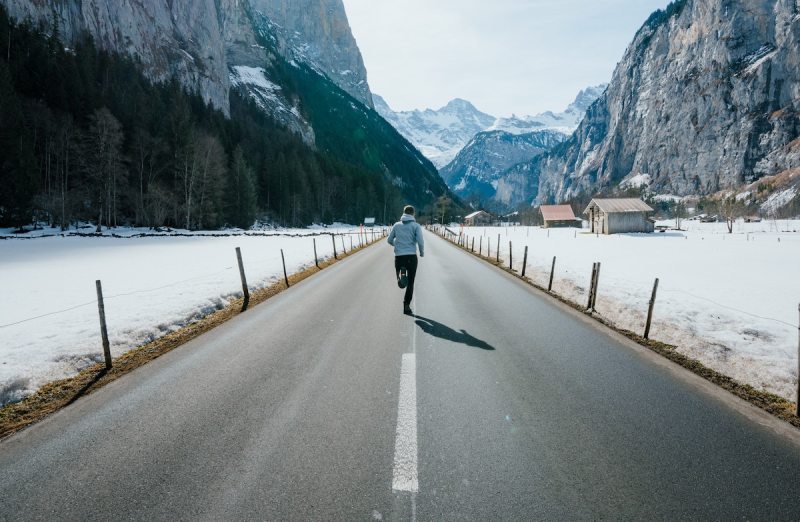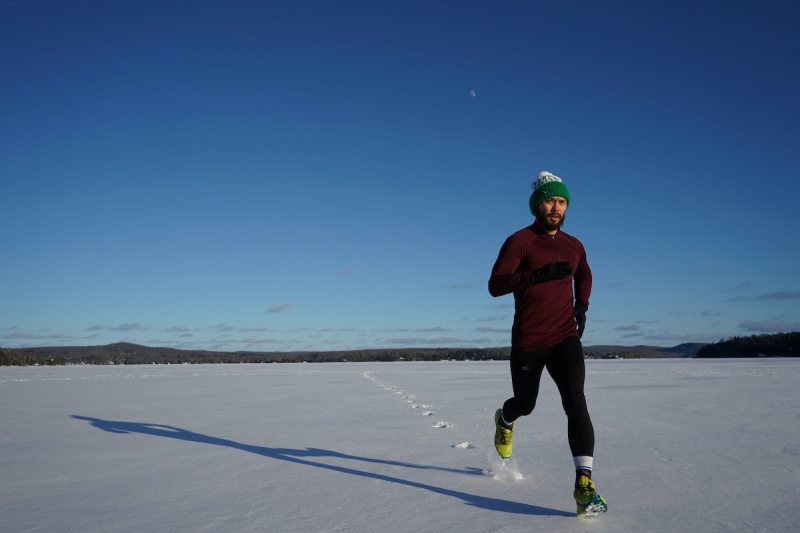
The lower the temperature plummets in the winter months, the fewer runners you’ll see out on the roads or weaving around the trails. Thousands of runners will forgo running on frigid cement streets and frozen backwoods paths for climate-controlled gyms with Wi-Fi enabled treadmills.
The runners still putting in the miles outdoors seem like a rare breed, but any runner, regardless of skill level, can put in the miles outside even when the temps drop into the teens.
It only takes a few outdoor running sessions for your body to get acclimated to running in cold weather.
“Once you begin training outdoors, your body will adapt quickly to the environment. You can definitely train outdoors every day if you are taking care of your dietary and hydration habits and dressing properly,” explains John Shackleton, strength and conditioning coach for the Villanova Wildcats men’s basketball team.
Below are some suggestions to make running in cold weather a little more bearable, including tips on warming up, paying attention to diet and hydration, and how to layer for optimal performance.
Spend Time Warming Up
Runners tend not to warm up for as long as they should because of a lack of time or just considering all the activity before a run as a warmup. Getting the body ready is crucial for an effective run, especially when running in cold weather.
To effectively get the body prepared for the long, cold miles ahead, runners should immerse themselves in the freezing temperatures as soon as possible.
“You want your body to acclimate to the environment in which you will be training,” Shackleton says. “Start out with a light jog or walk for 5 minutes. You can then get into some light static and dynamic stretching before you get into the actual workout. At the end of the workout, you can cool down for a few minutes outside to get your heart rate down.”
Don’t spend too long outside after a strenuous and sweaty winter run. Get back inside and out of any wet clothes before performing any static stretching and hop into a hot shower as soon a possible. The warm water will increase blood flow, helping warm you up quicker and reduce muscle tightness or soreness.
Pay Closer Attention to What You Eat
When training in cold weather, it will be essential to make sure you are focusing on your hydration habits — we’ll come back to that in a bit — while also maintaining a well-balanced diet.
Shackleton explains, “Cold weather exposure will increase the use of glycogen (carbohydrates stored in the liver and muscle) for energy. If you are not fueled properly for training in cold weather, you could go into a state of hypoglycemia (low blood sugar) which could suppress shivering and cause your core body temperature to drop. Shivering is essentially your body contracting its muscles to produce heat to warm itself. If stored energy is depleted, your body can’t shiver, and you will run the risk of hypothermia.”
“Coach Shack” advises eating a well-balanced meal the night before a run and two hours before the run. Examples of a well-balanced dinner include grilled chicken or salmon, sweet potatoes, and broccoli, all cooked in a little olive oil. A runner can never go wrong with oatmeal for breakfast, or try eggs with spinach and some fruit.
Stay Hydrated
Chugging water after a long run is easy to remember in the warm weather, but running in the cold weather often leaves athletes just not as thirsty as when training in extreme heat.
Staying hydrated in the winter is just as crucial for optimal performance before and after extensive exercise sessions.
“For your body to maintain its core temperature in cold environments, it will constrict the blood vessels in the periphery (near the skin), sending blood centrally (organs) as a thermoregulatory mechanism to maintain homeostasis,” Shackleton says. “This shunting of blood to the core elicits cold-induced dieresis or frequent urination resulting in a water loss in the body.”
To reduce the risk of becoming dehydrated, Shackleton suggests increasing water intake the night before a long run in the lower temps. He also advocates for adding a pinch of sea salt to the water to help with absorption.
Layer Accordingly

Dressing correctly for running in the cold weather can be highly frustrating. A person typically dresses for the temperature, but running involves both sweating and not being too bundled so that the clothing restricts movement. The sole purpose of your cold-weather running attire should be to trap the heat your body produces to keep you warm. At the same time, you also want moisture and sweat to evaporate.
Depending on the temperature — for this example, let’s assume the air is hovering around 32 degrees right before your run — Shackleton suggests a three-layer approach to your running gear.
“The first layer will be in direct contact with your skin, so you want to make sure you are wearing something that will allow sweat to evaporate, such as a moisture-wicking material like polyester. The middle layer should be fleece made from cotton to absorb the sweat being transferred from the base layer while also preventing heat loss. The third layer of clothing should be wind and water-resistant — typically made from polyester — while letting the sweat from the middle layer to evaporate.”
Try to Stick to Daylight Hours
Every person adheres to a different life schedule, and sometimes runners have no choice but to hit the roads and trails before the rest of the world wakes up or after a long workday. If possible, just for the winter months, try to run when the sun is working its hardest.
The first and most obvious reason for running during daylight is that the temperatures will be slightly higher. The increased exposure to sunlight is vital for vitamin D intake and an overall better mood. In other words, the sunlight will make the longer runs on colder days slightly more tolerable. Another reason to run when the sun is up is to reduce the possibility of injury and avoid any unseen dangers on the road like potholes or black ice.
If life circumstances leave you no choice but to run before the sun comes up or after the sun goes down, be sure to wear reflective gear so motorists know to share the road, and equip yourself with a headlamp and belt or shoe lights to illuminate the streets for a safer run.
Get the Right Sneakers

Buying brand new running sneakers is always fun, and what better way to prepare for the long, frigid winter than hot new kicks? Runners should continuously rotate sneakers, no matter the temperature, but the winter months call for more rotation because of the elements. There are hundreds of running sneakers made explicitly for winter. These kicks come equipped with weatherproof features to tackle the elements like slushy and slick sidewalks and miles of trails littered with deep mud and half-melted snow.
Two specific features to pay attention to when buying sneakers for running in cold weather are weatherproof uppers — to keep your socks and feet from getting soaked — and outsoles that grip the road so you’re not slipping and sliding your way through your daily run.
Don’t Forget to Change It Up
As with any exercise routine, diversity is the key to success. Shackleton suggests rotating runs indoors and outdoors, depending on the type of run.
“Try using a treadmill or indoor track for the days where you want to do higher intensity interval runs. On these higher intensity running days, your muscles will need to contract and relax at higher velocities, and indoor training would be ideal. Save your longer steady-state runs for outside in the colder temps.”



